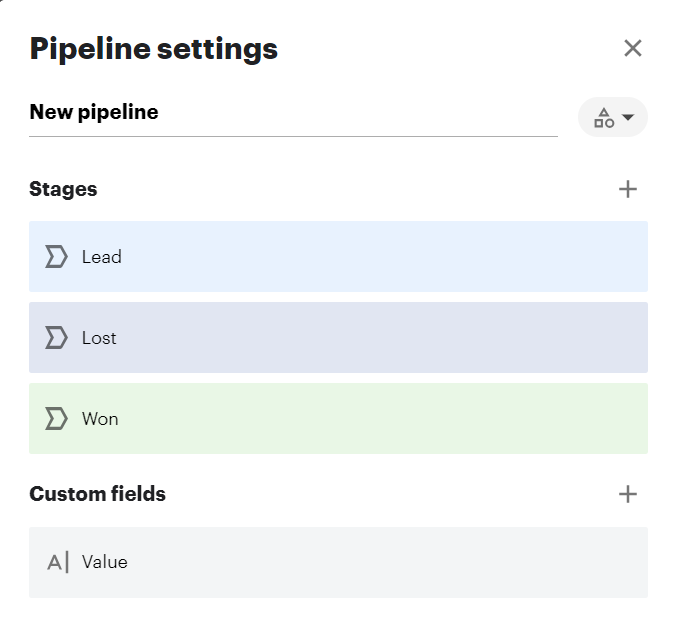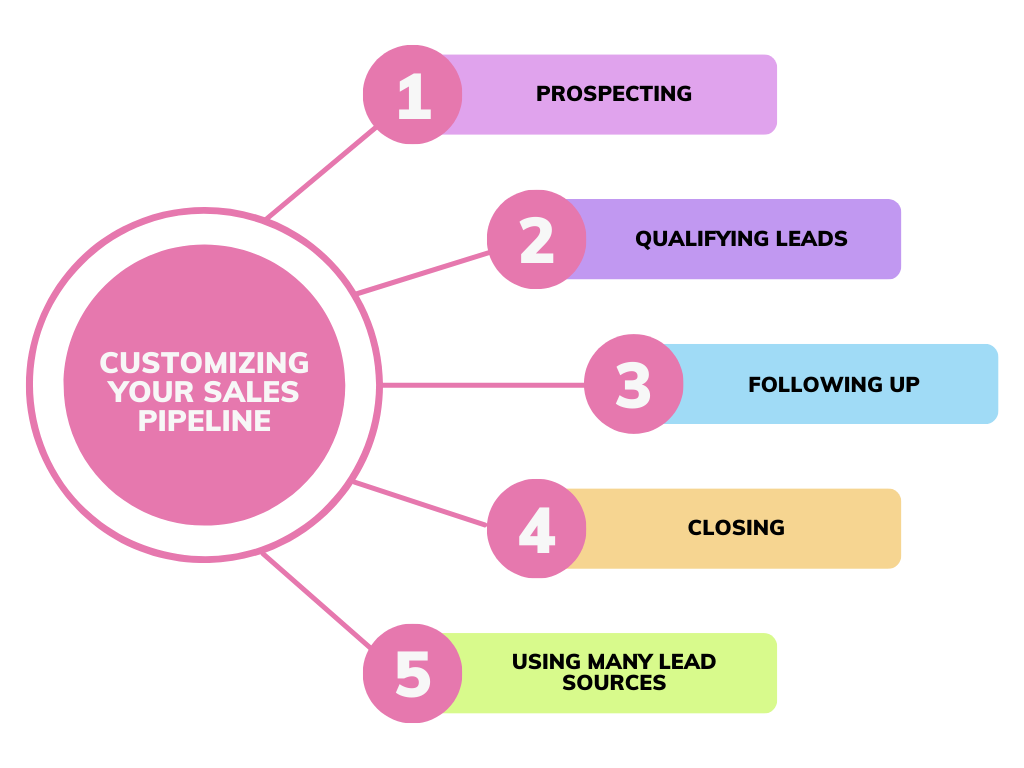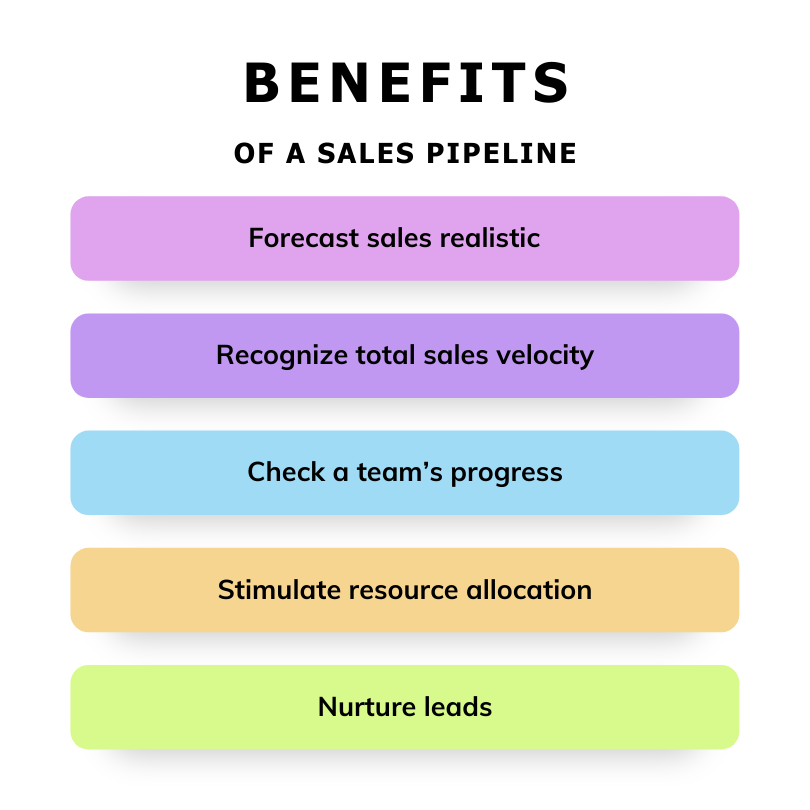Discover the power of a sales pipeline in CRM to transform your business and predict future revenue with greater accuracy. A CRM pipeline represents prospects and their position in the sales process. It helps you make data-driven decisions.
Dive into our comprehensive guide and learn what you need to know to reap the benefits of an efficient sales pipeline in CRM. Continue reading and master the art of sales pipeline.
What Is a Sales Pipeline?
A CRM sales pipeline visually represents where potential customers (prospects) are in your sales funnel. It allows you to organize, track, and manage trading activities. This includes information and other signals to generate predictable, efficient, and adequate revenue.

What is pipeline management in CRM? It refers to tracking sales opportunities from start to finish. It also analyzes the failures and successes to make improvements. Effective pipeline management helps your company define ideal trading strategies that promote growth.
Sales pipeline software includes various tools that help businesses manage and analyze their selling process. Sales pipeline management software is available. Some of these are Salesforce, HubSpot, and Zendesk, which are among the top contenders.
How Does a Sales Pipeline Help Businesses Achieve Sales Goals
A sales pipeline is a vital tool that assists businesses in achieving their sales goals. By comprehending what is a sales pipeline and learning how to construct one, companies can manage their selling process and drive revenue growth.
A CRM sales pipeline represents potential customers and their position in the sales funnel. This visibility helps businesses identify opportunities, track progress, and divide resources. It enables companies to make data-driven decisions that increase deal conversions and revenue.
Building a sales pipeline involves defining the stages of your selling process and mapping out the customer’s journey. This enables you to check the progress of leads and identify any bottlenecks or areas for improvement. It helps in forecasting future revenue and setting realistic sales targets.
A sales pipeline is crucial in helping businesses achieve their goals by providing insight into the selling process. It enables efficient resource allocation and facilitates data-driven decision-making. Companies can optimize their sales strategies and drive sustainable growth by understanding how to build a sales pipeline.
Which Areas of Your Sales Pipeline Should You Customize?
Customizing your sales pipeline is essential for optimizing its efficiency and effectiveness. In this section, we’ll explore the critical areas of your sales pipeline you can tailor to your business needs using CRM software.

Prospecting
Prospecting is the initial stage of identifying potential customers. Customizing this area of your sales pipeline allows you to focus on specific industries, demographics, or customer needs. It’ll ensure that your sales team targets the most relevant and promising leads.
Qualifying leads
Qualifying leads involves determining if a prospect is a good fit for your product or service. By customizing this stage, you can establish specific criteria and scoring systems to focus on leads. This will help your commercial department focus on high-quality prospects with a higher likelihood of conversion.
Following up
Adequate follow-up is crucial for nurturing leads and moving them through the sales pipeline. Customizing your follow-up process ensures that your team’s communication is consistent, personalized, and timely. It’ll improve your chances of closing deals.
Closing
Closing is the last step in securing a sale. Customizing this area allows you to tailor your closing techniques, negotiation strategies, and pricing options to suit the needs of your prospects better. This will increase the likelihood of successful conversions.
Using Many Lead Sources
Using many lead sources can help diversify your sales pipeline and increase your chances of finding the right prospects. Customizing this aspect enables you to integrate various lead-generation channels. It includes social media, email marketing, and referrals, ensuring a steady flow of potential customers.
Benefits of a Sales Pipeline
A sales pipeline offers many benefits to improve your business’s sales performance. This section will discuss the advantages of using this visual representation to manage and optimize your selling process.
Forecast Sales Realistic
A sales pipeline enables you to forecast sales by providing a clear view of the opportunities in each stage of the selling process. This lets you predict revenue based on historical data and conversion rates. It’ll help you set realistic sales targets and make informed decisions about future growth strategies.
Recognize Total Sales Velocity
Sales velocity is the rate at which your leads move through the sales pipeline. Using a visual representation, you can identify the total sales velocity. This will help you identify and resolve barriers, improve sales efficiency, and increase revenue.
Check a Team’s Progress
A sales pipeline provides a comprehensive overview of your sales team’s progress. It’ll help make tracking individual and collective performance easier. This visibility allows you to identify areas of improvement, provide targeted coaching, and ensure that your team stays focused on achieving their deals goals.
Stimulate Resource Allocation
Using a sales pipeline, you can divide resources into different sales process stages based on the number of leads and their potential value. This ensures that your team focuses on high-priority opportunities. It’ll maximize the ROI for your sales efforts.
Nurture Leads
A well-structured sales pipeline helps you nurture leads by understanding each prospect’s position in the sales funnel. This enables you to tailor your communication and follow-up strategies to address their needs and problems. It’ll help increase the likelihood of converting leads into customers.

Sales Pipeline vs. Sales Funnel
Understanding the critical differences between a sales pipeline and a sales funnel is crucial. It’ll help you manage your selling process better. This section will explore the distinctions between the two concepts. It’ll examine how the “sales pipeline vs. sales funnel” debate affects your sales strategy. A sales pipeline is a tool for managing and organizing leads. While a sales funnel focuses on analyzing and optimizing the selling process.
Both concepts are essential for a successful sales strategy. They provide valuable insights into the performance of your sales team and the effectiveness of your sales tactics. People often use the sales pipeline and sales funnel. But they represent distinct aspects of the selling process.
 Sales Pipeline
Sales Pipeline
A sales pipeline focuses on a prospect’s stages, from initial contact to closing a deal. It’s a linear representation of the selling process. It highlights the actions taken by the sales team at each stage. The pipeline helps the sales teams track and manage individual leads. This will ensure they receive appropriate attention and follow-ups.
 Sales Funnel
Sales Funnel
A sales funnel is a visual depiction of the conversion levels at different stages of the sales journey. The funnel narrows as leads progress, illustrating the decrease in prospects at each stage. The primary goal of the sales funnel is to identify areas where leads are dropping off. Then this will help you to optimize the process to improve conversion rates.
By understanding the nuances of the sales pipeline vs. sales funnel debate, you can better tailor your approach to maximize conversions and drive revenue growth.
How to Build a Sales Pipeline?
Embrace the power of flexibility in your sales pipeline. In creating an effective pipeline, it’s essential to understand that opportunities take different routes. For instance, referrals bypass some stages, entering the pipeline as pre-qualified leads.
They’ve sought your company and can proceed to the Qualifying Leads stage. Opportunities in your sales pipeline will exhibit varying levels of interest, urgency, and awareness about your company, products, or services.
A flexible entry point is crucial for nurturing these diverse opportunities. It’ll ensure a successful sales pipeline.
Step 1: Outline the Steps of Your Sales Process
Your sales pipeline or cycle will vary depending on your business model, sales approach, and the products or services you present. To create a tailored selling process, consider your unique business needs. Some companies may need separate pipelines for each department or development.
Others might find a single channel enough for their entire sales cycle. By understanding your business’s requirements, you can craft a selling process that optimizes results and drives success.
Step 2: Analyze Your Sales Funnel Metrics
To optimize your sales pipeline, track the progression of opportunities between stages. For example, if 100 chances are in Prospecting, what percentage moves to a Connect call? Recognize that not all options advance to the next stage.
Calculate the number of opportunities needed at each stage to achieve your revenue goals by working backward. Establish a clear baseline for opportunity movement. Use this data to determine how many targets you need at each stage to hit your desired deal numbers. This analysis is vital for accurate sales pipeline management.
Step 3: Identify patterns of success
Analyze the common factors that drive opportunities to advance through your pipeline stages. Are there specific triggers that lead to conversions, like a demo or a follow-up email?
By understanding these metrics, you can pinpoint the factors that encourage conversions. A well-defined process allows you to recognize patterns, enabling you to refine the process and optimize the ROI of your sales efforts.
Step 4: Improve Your Sales Process
Use the data-driven insights and patterns of success you’ve identified to create or adapt your selling process. This will cause a robust sales pipeline. Remember that the most effective sales processes can grow and adapt to the changing needs of your business, sales team, and industry.
By breaking your sales cycle into stages and monitoring the success of each, you can fine-tune your selling process and cycle length. This will ensure continuous improvement and growth.
Final Thoughts
A well-structured sales pipeline in a CRM system is crucial for managing leads and optimizing the selling process. By implementing a sales pipeline, you can forecast sales, recognize total sales velocity, check team progress, stimulate resource allocation, and nurture more leads.
Integrating a sales pipeline with CRM software streamlines the process. It’ll make tracking and managing leads easier while providing valuable insights into their progress. This integration enables better communication, follow-ups, and targeted marketing efforts. It’ll improve conversion rates and boost revenue.
InboxCRM from PandaDoc is an excellent tool that simplifies the CRM process. It’s a browser extension that integrates with your Gmail inbox. It allows you to manage leads, track deals, and access important information from your Gmail.
Incorporating a sales pipeline into your CRM system is essential. It maximizes the effectiveness of your trading strategy. To further enhance your selling process and simplify CRM management, consider using InboxCRM from PandaDoc.
This convenient tool can help you organize your workflow and centralize your data. To get started, you can download the browser extension InboxCRM from PandaDoc and experience the benefits for yourself.
FAQs
-
A pipeline in CRM refers to a visual representation of your selling process. This will showcase the progression of leads, prospects, and customers through various sales cycle stages. It helps businesses check their sales funnel, identify bottlenecks, and optimize commercial performance.
-
To create a pipeline in CRM, first define the stages of your selling process. Then, input these stages into the CRM system and assign leads, prospects, or customers to the location. Customize the pipeline to suit your business needs and check progress as deals move through the stages.
-
Pipeline management in CRM involves many aspects. This includes monitoring, analyzing, and optimizing the flow of leads, prospects, and customers. It allows businesses to recognize trends, fix problems, and make data-based decisions. It improves selling tactics and secures lasting success.


